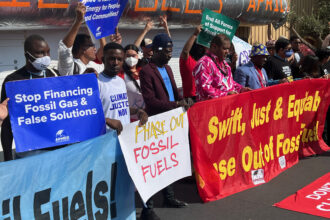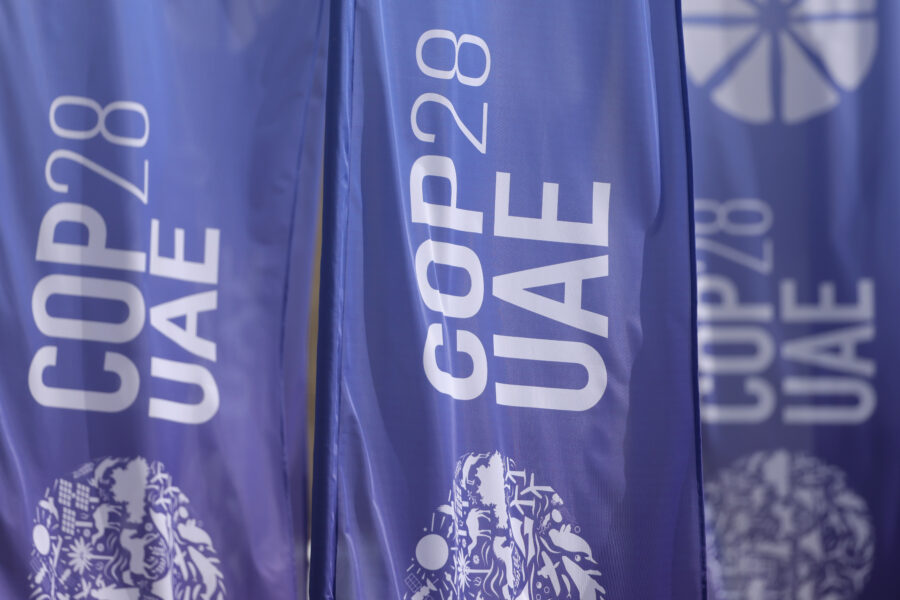New climate talks between the United States and China could set an encouraging signal for the upcoming United Nations COP28 climate summit, but only if the world’s biggest greenhouse gas polluters follow up on their words with actions.
If the two countries don’t make big emissions cuts soon, the world is likely to quickly heat well beyond the 1.5 degree Celsius goal of the Paris Agreement, new research shows. But the joint statement from China and the U.S. released late Tuesday does not mention fossil fuels as the root of the climate problem. That strikes activists and many energy analysts as a key omission that enables governments to pursue contradictory climate policies, as noted by climate journalist and activist George Monbiot.
But if cooperation between the U.S. and China leads to some real progress toward reducing emissions, it could benefit the larger COP process, where it has been cumbersome and time-consuming to find consensus among nearly 200 countries for minor side agreements, and almost impossible to do so for controversial topics like a fossil fuel phaseout, said Aaron Thierry, a social scientist at Cardiff University.
As a result, he said, some international climate policy analysts have started discussing the need to create bilateral treaties between some of the big players to begin making real progress on cutting emissions.
“You’ve got half of all emissions coming from just a few countries,” he said. “They need to sit down, and then, once they’ve made some agreements between themselves, then everybody starts to get on board because it sets the agenda.”
Such agreements don’t have to supplant the United Nations Framework Convention on Climate Change (UNFCCC) process, but could augment that broader global effort, he added.
And cooperation among the big polluter countries in between the annual climate summits could also relieve some of the pressure that builds each year around COP, which carries expectations that every new round of the talks will deliver some sort of silver bullet deal to fix the climate.
Those expectations are misplaced, Thierry said, because progress on climate will come from more decisive and consistent action by national governments, not from a breakthrough agreement at the annual conference. And waiting for a COP climate miracle takes away agency from the majority of people and countries because it leaves them waiting for an outside solution instead of acting themselves, he said.
COP28, from Nov. 30 to Dec. 12 in Dubai, is another step on the incremental path to implementing the Paris climate pact, and includes what the U.N. calls the first global stocktake, a detailed checkup of progress toward the goal. The stocktakes, mandated every five years, are an important part of the Paris Agreement meant to spur increased ambition with updated pledges toward greater emissions cuts.
Even before the stocktake, several recent reports show that global climate action is falling far short, with estimates that the world is now headed for about 2.5 to 2.7 degrees Celsius of heating, a level that dramatically raises the risk of climate impacts like multiple, simultaneous crop failures and widespread and persistent, life-threatening heatwaves that could triple the number of heat deaths globally by 2050.
The tepid language of the joint U.S.-China statement is not likely to change that equation much, said David Waskow, a climate policy analyst with the World Resource Institute, a nonprofit climate think tank in Washington. But rapid greenhouse gas reductions from both countries are key to meeting global climate goals, he added.
The statement’s reiteration of the G20 Leaders’ promise to triple renewable energy capacity globally by 2030 could help advance climate action if it’s reflected by a clear commitment in the final COP28 outcome, he said.
“But it is disappointing that the two nations said nothing about the need to rapidly transition away from fossil fuels this decade, which will be a central issue at the COP28 summit,” he said.
Progress on Methane Reductions?
An agreement by both countries to include methane in their next national climate plans is also important because it was absent from China’s existing pledge under the Paris Agreement, and China is the world’s largest methane emitter. Climate policy makers have increasingly leaned into methane-reduction plans in recent years after failing to cut CO2 emissions significantly in most countries. In the new statement, the U.S. and China invited other countries to a methane and non-CO2 Greenhouse Gases Summit at COP 28.
Methane traps 81 times more heat in the atmosphere than CO2 over 20 years, so big cuts could help avoid warming in the short term, as CO2 reduction and removal ramps up. But there is also worrying recent research showing that natural sources on land and at sea are the biggest driver of the recent spike in the atmospheric methane concentration, and that the current level even suggests that Earth’s climate is already tipping into a different, much warmer pattern.
Still, curbing methane emissions from human activity is widely viewed as one of the best things governments can do to combat climate change in the near term.
“It’s the biggest and it’s the fastest thing we can do,” Durwood Zaelke, president of the Institute for Governance and Sustainable Development, an environmental organization based in Washington, said.
Reducing methane emissions by 45 percent by 2030 would avoid nearly 0.3 degrees Celsius of global warming by the 2040s, according to a recent UN assessment.
The joint statement follows the long-anticipated release of China’s official plan to curb methane emissions, which was made public on Nov. 7
The plan includes developing systems to monitor and report emissions, capture and utilize methane from coal mines and oilfields and reduce emissions from agriculture and landfills.
Nearly 150 countries including the U.S. have signed a global methane pledge that aims to cut methane emissions by 30 percent by 2030. China has not signed on and, while its recently released methane plan does not set an overall target or timeline for emissions reductions, Zaelke said it goes beyond the non-binding global methane pledge.
Quickly following the announcement, the EU announced new restrictions on methane emissions—including from natural gas imports—on Wednesday, a move that will likely strengthen global efforts to curb methane emissions leading up to COP28. The proposed methane standard by the world’s largest buyer of natural gas would set a “maximum methane intensity” for natural gas and other fossil fuels beginning in 2030 that would effectively place a fee on non-compliant fuels imported into the EU.
The U.S. and China also agreed to cooperate on efforts to curb emissions of nitrous oxide and hydrofluorocarbons (HFCs), other non-CO2 greenhouse gases. A small number of chemical plants in both countries have historically released outsized emissions of nitrous oxide and HFC-23, one of the world’s most potent greenhouse gases, despite proven, low-cost pollution controls. Reducing HFCs and other short-lived climate pollutants along with methane could avoid 0.6 degrees Celsius of additional warming by 2050.
A Vague Agreement on Carbon Capture
The only specific target in the statement is for each country to advance five large-scale carbon capture projects by the end of the decade. But they didn’t define large-scale. China has begun focusing more in recent years on technology to remove carbon dioxide emissions from industrial smokestacks. It has 11 plants that capture smokestack emissions in operation now, according to the Global CCUS Institute, but they are all small in scale: Collectively they have the capacity to capture less than 4 million metric tons of CO2 per year, or less than one-tenth of 1 percent of the nation’s climate pollution.
Carbon capture technology is likely necessary to decarbonize some industrial processes like producing cement, but Waskow said it will make up just a sliver of the total emission reductions needed to keep climate goals within reach.
Keep Environmental Journalism Alive
ICN provides award-winning climate coverage free of charge and advertising. We rely on donations from readers like you to keep going.
Donate Now“At COP28, it is important that negotiators clearly articulate the limited role that carbon capture technology will play in tackling the climate crisis,” he said.
Some advocates for carbon capture and storage have pointed to China as a reason why the technology must be deployed on existing coal plants. In the United States, it will likely be cheaper to retire the vast majority of the nation’s coal plants earlier than planned, if needed, and replace them with wind and solar energy. But China’s coal fleet is much larger and younger, on average, making it more likely many plants will run for longer. Without carbon capture, these proponents have argued, the plants will likely continue polluting for decades.
Carbon capture has begun to be incorporated into diplomatic language on climate change, if not by name: The final text from COP27 included an agreement to accelerate “efforts towards the phasedown of unabated coal power,” a carve-out that would allow for coal plants to continue operating if they were fitted with carbon capture technology.
Whether or not the new climate dialogue between the U.S. and China leads to any breakthroughs at COP28 remains to be seen, but it could, Waskow said, mark recognition by the world’s two biggest climate polluters that “they have a unique responsibility to accelerate climate action at home and bring all countries together to find common ground.”











